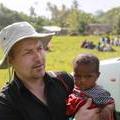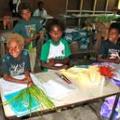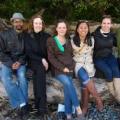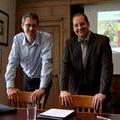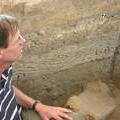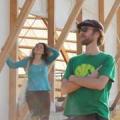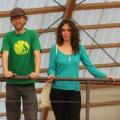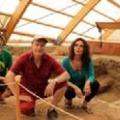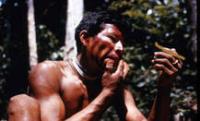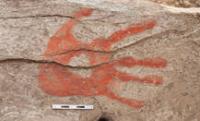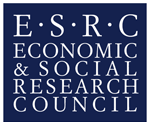If asked to list the defining features of being human, you’d probably cite our formidable linguistic prowess, our finely tuned moral sense and our unrivalled capacity for creative invention as crucial elements. All have no doubt played a part in making us the globally dominant species we are, enabling us to share ideas, form close-knit moral communities and devise ways to eke out an existence in an unprecedented variety of environments, from the scorching heat of the desert to the freezing winds of arctic tundra.
But perhaps an equally important factor in the success of our species has been our capacity for blind imitation. This ability to copy other people, rather than our braininess, underlies the very possibility of complex culture, in which the knowledge, innovations and insights of one generation are transmitted down the line.
Cultural imitation is a universal human trait. Every person on the planet (barring those with certain cognitive deficits) is biologically equipped to pick up the knowledge and skills nurtured by any culture that has existed: if a Palaeolithic infant could to be transported in a time machine to the present, she would no doubt develop much like any other normal child, learning to read and write and to use all the advanced technologies that wealthy people of the twenty-first century have at their disposal.
But we’re not smart enough to invent complex culture in a single generation: if all the accumulated knowledge of our species were to be annihilated overnight, it would take another 100,000 years to accomplish anything like our present levels of scientific and technological accomplishment (if indeed we would recover our lost riches at all). Despite our undoubted capacities for sophisticated reasoning, creative invention, and technological innovation, humans remain a deeply imitative species, and for most of the human past this is mainly how we preserved the cultural wisdom of the ages.
As quintessentially cultural creatures, we imitate all sorts of behaviours. Some of these are technical skills that help us get by in the world. For the Inuit, this might be how to build a kayak or fashion snow boots; for your average Westerner, it might be how to drive a car or use a smartphone. With technical skills, there’s a clear outcome in mind, and we can see how certain physical actions can ensure that we achieve these goals — when we see someone successfully doing what we want to do, it makes sense to copy them.
But in addition to technical skills, we also imitate behaviours where the link between what we do and some hoped-for outcome is much less clear — rituals being a prime example. People engage in ritual activities for all sorts of reasons: to commune with the divine, to mark changes in status, to bury the dead, and sometimes for no reason at all that anybody can remember. But the means by which rituals are supposed to achieve their goals (if any) are typically opaque, in that the relationship between the conventional rules for performing the ritual, and its end goal (if it has one), lies beyond the kind of causal explanation that underlies technical skills. Indeed, in many cases it’s assumed that such an explanation is not only unavailable, but not even possible in principle: you simply have to do things this way, and that’s that.
As such, rituals are defined less by the content of the observable behaviour itself, but by the way we, as observers and participants, understand the action — that is, by the interpretative stance we adopt towards it. As an Englishman I know that an outreached hand invites me to shake it but I do not expect my capacities for causal reasoning to deliver an explanation for this peculiar convention; I understand this behaviour from a ritual stance. On the other hand, the same outstretched hand as I hang on for dear life to a cliff top is immediately recognizable as a means by which I may be hauled to safety; here, I would be adopting an instrumental stance. Being unable to tell the difference, to fail to adopt the right stance, could quite literally be a matter of life and death.
The puzzle is why we adopt a ritual stance at all, and why we routinely imitate behaviours for which there is no causal or instrumental rationale. The Ritual, Community, and Conflict project is trying to find out why.
The first objective of our project, led by Cristine Legare and her lab (University of Texas at Austin), is to understand how young children learn the difference between ritual and instrumental stances on behaviour, as well as how social cues influence the salience of the two stances and affect patterns of social learning by imitation. In our initial experiments we’ve shown that children copy causally opaque behaviour more rigidly, with less inclination to innovate, when the ritual stance is more salient, and we’re currently exploring the effects of ostracism threat, conformism bias, and other social cues on ritual learning.
Since rituals are typically unintelligible in terms of mechanistic causation, they spawn a potentially infinite universe of behavioural diversity. Human populations living side by side may have much in common, adopting the same basic techniques of production, using similar tools, exploiting similar natural resources and foodstuffs, living in similar kinds of houses, and so on. Indeed, at the level of practical affairs and day-to-day life there may be little to tell them apart — people cannot distinguish themselves from their neighbours by continually inventing new ways of tackling the technical challenges of life.
Rituals are a different story. Arbitrary conventions for how to achieve certain goals (placating the gods, ensuring an adequate crop and so on) act as admirable group markers partly because they are of little or no use to those outside the group. Indeed the same may be said of individual identity markers.
Rituals, however, not only demarcate people; they also bind them together. Our project’s second objective, led by Jon Lanman (Queen’s University Belfast) and Ryan McKay (Royal Holloway), is to investigate the psychological mechanisms by which rituals promote social cohesion. One of our current hypotheses concerns the relationship between ritual meaning and social identity. The fact that the ritual actions are not in principle intelligible in mechanistic terms means that we can endow them with many possible functions and meanings. But if interpreters do not know very much about what others are privately thinking, the ‘false consensus bias’ (a well-documented phenomenon in social psychology) encourages the impression, however illusory, that what is personally meaningful and motivating about the experience of joining in is shared by other participants.
This insight, reinforced by my own observations of ritual groups in the jungles of Papua New Guinea, led to further research on ‘rites of terror’ and the so-called ‘imagistic’ mode of religiosity, in which important rituals are infrequent and highly emotionally arousing. Imagistic practices generate powerful bonds between participants based on shared experiences of ritual ordeals in small, face-to-face communities. (This contrasts with the ‘doctrinal mode’ of religiosity, which is characterised by frequent but relatively tame rituals that help foster larger, anonymous but expandable communities with higher levels of orthodoxy and dynamic leadership.)
We’re now beginning to connect these ideas with a new branch of research in social psychology that examines the nature and consequences of ‘identity fusion’. One of the world’s leading experts on this topic, Bill Swann (University of Texas at Austin), is helping us to develop novel lines of investigation into the role of ritual in fusing groups of people together into cooperative units. Together with Jonathan Jong (Oxford) and the rest of the team we are exploring these issues experimentally in the lab, as well as running surveys online and developing new methods of field observation.
Group formation is one of the most adaptive and yet also perhaps the most devastating of all human traits. Without groups, we could not wage wars, commit genocides, or colonize other people’s lands. While there is much to lament about human groupishness, there is also much to admire in this proclivity as it gives rise to acts of altruism, loyalty, camaraderie, heroism, and love. But these qualities typically extend only to the group (family, tribe, or nation). Beyond the group, caution and suspicion reign: when provoked by members of rival coalitions, organized violence can easily erupt.
Social cohesion whets the appetite for such conflict. To study these processes up close, Brian McQuinn (Oxford) went to live among revolutionaries in Misrata, Libya, during the popular uprising that led to the overthrow of Gaddafi’s regime. Observing the formation of rebel groups from the inside, Brian has been able to study directly how the rituals of military brigades, and their shared ordeals on the battlefield, bound them together. In December last year, in the aftermath of the revolution, I joined Brian in Libya, and we met with some of the military leaders and fighting units. Together, we designed a questionnaire using measures of identity fusion, which was then administered by a trained member of one of the brigades. The results supported our hunch that shared traumatic ordeals bind people together even more closely than other kinds of shared experience. The project team is also testing this hypothesis by surveying veterans of the Vietnam War, members of university sororities who have undergone painful or humiliating hazing rituals, mothers who had particularly traumatic birthing experiences, survivors of disasters, and other groups that are formed around shared experiences of suffering.
Our project’s third objective is to understand the role of ritual in the evolution of social complexity. Until just a few thousand years ago, group rituals were typically occasions for high excitement but nowhere had people yet begun to regularize their rituals around daily or weekly cycles. High-frequency ritual (or routinization) is a hallmark of world religions and their offshoots, but is also characteristic of a great many regional religions and ideological movements. Routinized rituals play a major role in the formation of large-scale identities, enabling strangers to recognize each other as members of a common in-group, facilitating trust and cooperation on a scale that would otherwise be impossible. This way of being religious heralds not only the first large-scale societies, but also the first complex political systems in which roles and offices are understood to be detachable from the persons who occupy them.
A watershed in the evolution of modes of religiosity seems to have occurred around 8,000 years ago at Catalhoyuk, in what is now Central Anatolia in Turkey. Discovered in 1958 by British archaeologist James Mellhart, Catalhoyuk is one of the largest Neolithic settlements in Southwest Asia. It was founded around 7,300 BC, and occupied until at least 6200 BC, providing a home to thousands of people who lived side by side in closely packed houses.
In the summer of 2011, Quentin Atkinson (Auckland), Camilla Mazzucato (Oxford), and I went to stay at Catalhoyuk to try to reconstruct the ritual lives of the Neolithic peoples who established the settlement. With the help of many archaeologists and the director of the site, Ian Hodder, we uncovered much evidence of rare, emotionally intense rituals, including animal bones resulting from hunting and feasting activities, pictorial representations of major rituals, and human remains that were manipulated in elaborate mortuary practices. These practices would have fused together highly cohesive groups necessary for coordinated hunting of large, dangerous animals. The boundedness of these groups may still be visible today in the massive trenches that appear to have divided communities in the earlier phases of settlement.
But as hunting gradually gave way to farming, the need for such groups disappeared and instead more day-to-day forms of cooperation across the settlement were required to sustain novel forms of specialized labour, reciprocity, pooling, and storage. Sustainable exploitation of the commons now required the dissolution of small-group boundaries and inter-group rivalry in favour of larger-scale forms of collective identity, trust, and cooperation extending to tens of thousands of individuals at the enlarged settlement.
This change in the scale of political association was facilitated by the appearance of the first ever regular collective rituals, focused around daily production and consumption, and the spread of identity markers across the entire settlement, for instance in the form of stamp seals used for body decoration and more standardized pottery designs. Now we are building databases spanning a much wider region in the Near East and covering a longer time period from the late Palaeolithic to the first Bronze Age civilizations. And together with Peter Turchin and Pieter Francois, as well as an army of historians, we are also building a massive historical database that will enable us to quantify patterns of relationships between ritual, social organization, and inter-group competition over 5,000 years of global history.
Ritual is popularly misconstrued as an exotic, even quirky topic – a facet of human nature that, along with beliefs in supernatural agents and magical spells, is little more than a curious fossil of pre-scientific culture, doomed to eventual extinction in the wake of rational discovery and invention. Nothing could be further than the truth. Humans are as ritualistic today as they have ever been. This is not a comment on the changing fortunes of organised religion in different parts of the world (growing and spreading in some places while undoubtedly declining in others). It is a point about the profoundly ritualistic character of all human cultures, whether in families, schools, workplaces, governments, and international relations. Rituals persist even where gods do not. Even the most secular political systems ever devised — for instance, those under the sway of historical materialism and its vision of a Communist utopia — were as devoted to ritual as any in human history. Each time a child is born, a new bearer of rituals is created.


